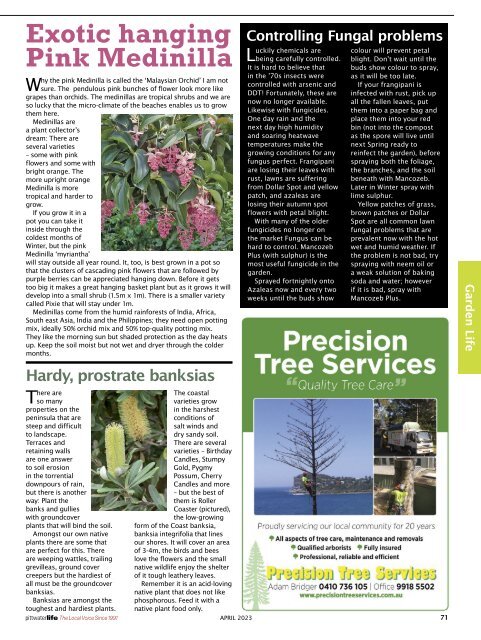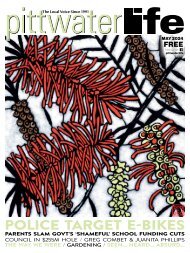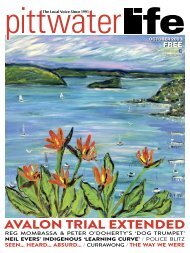Pittwater Life April 2023 Issue
NEW DAWN FOR PITTWATER SALLY MAYMAN SNAPSHOT / OUR WINDFOILING STAR ON RISE PLASTIC RECYCLING / MCCARRS CREEK BOAT SHED NIGHTMARE SEEN... HEARD... ABSURD / ANZAC DAY / THE WAY WE WERE
NEW DAWN FOR PITTWATER
SALLY MAYMAN SNAPSHOT / OUR WINDFOILING STAR ON RISE
PLASTIC RECYCLING / MCCARRS CREEK BOAT SHED NIGHTMARE
SEEN... HEARD... ABSURD / ANZAC DAY / THE WAY WE WERE
Create successful ePaper yourself
Turn your PDF publications into a flip-book with our unique Google optimized e-Paper software.
Exotic hanging<br />
Pink Medinilla<br />
Why the pink Medinilla is called the ‘Malaysian Orchid’ I am not<br />
sure. The pendulous pink bunches of flower look more like<br />
grapes than orchids. The medinillas are tropical shrubs and we are<br />
so lucky that the micro-climate of the beaches enables us to grow<br />
them here.<br />
Medinillas are<br />
a plant collector’s<br />
dream: There are<br />
several varieties<br />
– some with pink<br />
flowers and some with<br />
bright orange. The<br />
more upright orange<br />
Medinilla is more<br />
tropical and harder to<br />
grow.<br />
If you grow it in a<br />
pot you can take it<br />
inside through the<br />
coldest months of<br />
Winter, but the pink<br />
Medinilla ‘myriantha’<br />
will stay outside all year round. It, too, is best grown in a pot so<br />
that the clusters of cascading pink flowers that are followed by<br />
purple berries can be appreciated hanging down. Before it gets<br />
too big it makes a great hanging basket plant but as it grows it will<br />
develop into a small shrub (1.5m x 1m). There is a smaller variety<br />
called Pixie that will stay under 1m.<br />
Medinillas come from the humid rainforests of India, Africa,<br />
South east Asia, India and the Philippines; they need open potting<br />
mix, ideally 50% orchid mix and 50% top-quality potting mix.<br />
They like the morning sun but shaded protection as the day heats<br />
up. Keep the soil moist but not wet and dryer through the colder<br />
months.<br />
Hardy, prostrate banksias<br />
There are<br />
so many<br />
properties on the<br />
peninsula that are<br />
steep and difficult<br />
to landscape.<br />
Terraces and<br />
retaining walls<br />
are one answer<br />
to soil erosion<br />
in the torrential<br />
downpours of rain,<br />
but there is another<br />
way: Plant the<br />
banks and gullies<br />
with groundcover<br />
plants that will bind the soil.<br />
Amongst our own native<br />
plants there are some that<br />
are perfect for this. There<br />
are weeping wattles, trailing<br />
grevilleas, ground cover<br />
creepers but the hardiest of<br />
all must be the groundcover<br />
banksias.<br />
Banksias are amongst the<br />
toughest and hardiest plants.<br />
The Local Voice Since 1991<br />
The coastal<br />
varieties grow<br />
in the harshest<br />
conditions of<br />
salt winds and<br />
dry sandy soil.<br />
There are several<br />
varieties – Birthday<br />
Candles, Stumpy<br />
Gold, Pygmy<br />
Possum, Cherry<br />
Candles and more<br />
– but the best of<br />
them is Roller<br />
Coaster (pictured),<br />
the low-growing<br />
form of the Coast banksia,<br />
banksia integrifolia that lines<br />
our shores. It will cover an area<br />
of 3-4m, the birds and bees<br />
love the flowers and the small<br />
native wildlife enjoy the shelter<br />
of it tough leathery leaves.<br />
Remember it is an acid-loving<br />
native plant that does not like<br />
phosphorous. Feed it with a<br />
native plant food only.<br />
Controlling Fungal problems<br />
Luckily chemicals are<br />
being carefully controlled.<br />
It is hard to believe that<br />
in the ’70s insects were<br />
controlled with arsenic and<br />
DDT! Fortunately, these are<br />
now no longer available.<br />
Likewise with fungicides.<br />
One day rain and the<br />
next day high humidity<br />
and soaring heatwave<br />
temperatures make the<br />
growing conditions for any<br />
fungus perfect. Frangipani<br />
are losing their leaves with<br />
rust, lawns are suffering<br />
from Dollar Spot and yellow<br />
patch, and azaleas are<br />
losing their autumn spot<br />
flowers with petal blight.<br />
With many of the older<br />
fungicides no longer on<br />
the market Fungus can be<br />
hard to control. Mancozeb<br />
Plus (with sulphur) is the<br />
most useful fungicide in the<br />
garden.<br />
Sprayed fortnightly onto<br />
Azaleas now and every two<br />
weeks until the buds show<br />
colour will prevent petal<br />
blight. Don’t wait until the<br />
buds show colour to spray,<br />
as it will be too late.<br />
If your frangipani is<br />
infected with rust, pick up<br />
all the fallen leaves, put<br />
them into a paper bag and<br />
place them into your red<br />
bin (not into the compost<br />
as the spore will live until<br />
next Spring ready to<br />
reinfect the garden), before<br />
spraying both the foliage,<br />
the branches, and the soil<br />
beneath with Mancozeb.<br />
Later in Winter spray with<br />
lime sulphur.<br />
Yellow patches of grass,<br />
brown patches or Dollar<br />
Spot are all common lawn<br />
fungal problems that are<br />
prevalent now with the hot<br />
wet and humid weather. If<br />
the problem is not bad, try<br />
spraying with neem oil or<br />
a weak solution of baking<br />
soda and water; however<br />
if it is bad, spray with<br />
Mancozeb Plus.<br />
APRIL <strong>2023</strong> 71<br />
Garden <strong>Life</strong>
















